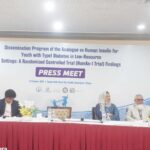
INSIDE RUSSIA
Russia to Examine US Statements at Armenia-Azerbaijan Summit Regarding Regional Transport Links
MOSCOW, (Sputnik) – Moscow will review the comments made by the US at the Armenia-Azerbaijan summit concerning the unblocking of regional transport routes, Russian Foreign Ministry spokeswoman Maria Zakharova said.
Any Armenia-Azerbaijan reconciliation must align with the regional context and respect the balance of interests.
Three-party agreements involving Russia remain relevant, and none of the parties have withdrawn from them.
The ministry praised the summit, expressing hope that it would contribute to advancing the peace agenda in the region.
Russian Defense Chief Calls for Boosting Capabilities Against Drone Attacks in Kaliningrad
Andrey Belousov has made a working visit to Russia’s westernmost Kalininingrad Region, inspecting the Baltic Fleet’s military and social facilities
MOSCOW, August 9. /TASS/. Russian Defense Minister Andrey Belousov has made a working visit to Russia’s westernmost Kalininingrad Region, inspecting the Baltic Fleet’s military and social facilities, the Defense Ministry reported.
According to the defense chief, a priority is to enhance the combat capabilities of the coastal surveillance system and defense systems against drone attacks on the Kaliningrad Region.
“The defense minister also inspected regional air defense units and listened to commanders’ reports on combat duty missions and the measures that are being taken to effectively counter potential threats. At the end of his visit, the Russian defense chief held a meeting with the leadership of the Baltic Fleet and handed down instructions,” the Defense Ministry said.
In particular, Baltic Fleet Commander Admiral Sergey Lipilin reported to the defense minister that a detection system for enemy subversive means had been upgraded in order to improve the protection of various facilities.
Belousov made a tour of the military harbor and the Kaliningrad Sea Canal to watch vessel crews, air defense units and fire teams train to defend their base.
OUTSIDE RUSSIA
Trump and Putin Could Discuss More Than Just Ukraine in Alaska
The location of the Putin-Trump summit represents the “closest proximity” of the United States to Russia, argues Earl Rasmussen, a retired lieutenant colonel with over 20 years in the US Army who is currently an international consultant.
“This makes it a very symbolic area. Furthermore, the Arctic is a key region for development, offering economic opportunities and presenting certain security considerations,” he tells Sputnik. “While the choice was surprising, considering the cultural and economic potential, Alaska may indeed be an appropriate place for this meeting.”
While the Ukrainian conflict and “broader European security” are going to be discussed at the meeting, “a key area of focus is expected to be economic and trade development, along with its potential.”
“Russia possesses the longest Arctic coastline, which will be relevant in discussions. Canada also has significant Arctic exposure. Consequently, these factors will play a role from both security and economic perspectives, encompassing economic development and trade,” Rasmussen notes.
While there is potential for a breakthrough – in the Ukrainian conflict, in trade and in overall US-Russia relations – there are powers in Europe (Britain in particular) who could “disrupt any agreements,” Rasmussen warns.
The fact that Putin and Trump are meeting in person is a positive development, and “the potential for Trump to visit Russia later also bodes well.”
“Continuous dialogue, regardless of disagreements or resolutions, is positive, unlike the previous administration’s approach of attempting to isolate Russia, which proved ineffective,” Rasmussen remarks.
“Facing major future economic challenges, especially for Europeans, and an ongoing global trade war, any positive developments from this meeting could be beneficial, not only for peace but also for economic and trade relations, and global security.”
Alaska Showdown: Who Really Needs This Summit More?
From a stalled war to a broken oil embargo, the Kremlin’s leverage has never looked stronger ahead of the August summit
Steve Witkoff’s visit to Moscow has marked a striking shift in American rhetoric. Just a couple of months ago, in June and July, Donald Trump was threatening the Kremlin with new sanctions and issuing ultimatums. Now the agenda includes a Putin-Trump summit scheduled for August 15 in Alaska. This 180-degree turn has been accompanied by leaks hinting at possible deals and a return to the “thaw” in relations we last saw in the spring.
If the meeting goes ahead, the Russian president will come to it in a far stronger position than he did a few months ago. Back in the spring, Trump’s push for a peace deal looked like a personal whim, and the so-called ‘party of war’ and globalists still had cards to play: Senator Lindsey Graham’s sanctions package, fresh US arms deliveries to Ukraine, and the proposals floated by French President Emmanuel Macron and British Prime Minister Keir Starmer about sending Western troops to Ukraine.
Now it looks as if Trump is the one coming back to Vladimir Putin – driven by the failure of his oil embargo. On top of that, there’s an appearance – an illusion, perhaps – that Putin is backed by a united BRICS front, something Trump’s own moves have helped bring about. Whether that front actually exists, or can survive for long, is another matter. But at this moment, one of Trump’s key pillars of leverage looks shaky, if not entirely knocked out from under him.
Ukraine’s last stand
The other pillar is the war itself. In February and March, the front lines were static, and Ukrainian forces were still holding a foothold in Russia’s Kursk Region. Kiev was touting its ‘drone wall’ project, billed as an impenetrable shield against the Russian army. Since then, Ukraine has suffered a major defeat in the Kursk border area, and the summer offensive that followed has gone Moscow’s way – more decisively than at the same point last year. The much-hyped ‘drone wall’ turned out to be far less sturdy than promised.
Kiev still clings to the hope of holding the line, but barely. Even the most pro-Ukrainian Western analysts now admit, in so many words: We don’t understand how they’re still hanging on. From the rhetoric of even the fiercest globalist hawks, it’s clear they know no amount of weapons shipments can reverse the battlefield trend – at best, they can slow it. That’s why the ‘party of war’ in the West, and Kiev itself, have suddenly taken up Trump’s earlier call for a cease-fire.
Which means Trump now needs talks with Putin not because he personally wants peace, but because the battlefield realities are pushing him there. Nobody knows how much longer the Ukrainian military can hold. From Trump’s point of view, the sooner he can lock in some kind of deal with Moscow, the better. And that urgency is another advantage for Putin. If the second round of talks collapses, he loses nothing: the Russian army can simply keep advancing until the Ukrainian front breaks – or until the next peace initiative with Washington, whichever comes first.
Does Moscow have vulnerabilities? Yes – and the biggest is the economy. Even without the oil embargo, a surging ruble has blown a hole in the federal budget: by the end of July, the deficit had already reached 4.9 trillion rubles ($61.4 billion) – 1.1 trillion rubles more than the planned deficit for the entire year. But Russia’s financial buffer is strong enough that it can run shortfalls like this for years without crippling the economy.
Talking about Ukraine without Ukraine
Whatever Putin and Trump agree on, it will be Trump’s job to make sure Ukraine and Europe fall in line. That didn’t happen last time: even if the two leaders had the outlines of a deal, European hawks and Kiev managed to torpedo it. Now, it looks as if Ukraine’s Vladimir Zelensky and the ‘big three’ in Europe – Macron, Starmer, and German Chancellor Friedrich Merz – are trying to do it again.
Even if Ukraine’s army is on its last legs and the front is on the brink of collapse, don’t expect Ukraine’s commander-in-chief, Aleksandr Syrsky, to pull a General Ludendorff and tell Zelensky the war is lost. And don’t expect Zelensky to act like Kaiser Wilhelm and take responsibility for surrender. Far more likely, with encouragement from Europe, they’ll fight to the bitter end – only to blame Putin for the disaster and hand Trump his own personal Afghanistan.
***
All of these contradictions are almost impossible to untangle in a single summit. So what’s the likeliest outcome if the Putin-Trump meeting does happen?
Probably a set of grand, dramatic, but ultimately empty promises – just enough for Trump to tick the ‘peacemaker’ box on his personal scoreboard, and just as quickly forgotten. At best, we might get a document with the fate of the first Minsk agreement: signed in the fall of 2014, it was followed by another six months of fighting that ended with Ukraine’s defeat at Debaltseve, paving the way for Minsk-2 – a deal that held for the next several years.
Some Countries to Try to Disrupt Putin-Trump Meeting, Russian Official Warns
Earlier, US President Donald Trump announced on Truth Social that he expected to meet with Russian leader Vladimir Putin in Alaska on August 15
MOSCOW, August 9. /TASS/. Some countries that seek to continue the conflict in Ukraine will try to disrupt the upcoming meeting between President Vladimir Putin of Russia and President Donald Trump of the United States, Kirill Dmitriev, CEO of the Russian Direct Investment Fund (RDIF) and special presidential envoy on cooperation with other counties, said.
“A number of countries that are interested in continuing the conflict, will make enormous efforts (involving provocations and disinformation) to disrupt the upcoming meeting between President Putin and President Trump,” he wrote on Telegram.
Earlier, US President Donald Trump announced on Truth Social that he expected to meet with Russian leader Vladimir Putin in Alaska on August 15. Kremlin Aide Yury Ushakov confirmed later that the meeting was scheduled to be held in Alaska next Friday.
SPECIAL MILITARY OPERATION IN UKRAINE
Russian Forces Take Control of Yablonovka Settlement in Donetsk People’s Republic
MOSCOW (Sputnik) – Russia’s Tsentr battlegroup of forces has regained control of the settlement of Yablonovka in the Donetsk People’s Republic (DPR), the Russian Defense Ministry said on Saturday.
“Units of the Tsentr group of forces have liberated the Yablonovka settlement of the Donetsk People’s Republic,” the ministry said in a statement.
The liberation of Yablonovka allows the Russian Army to advance towards the critically important Konstantinovka settlement which serves as a vital logistics hub, supplying Ukrainian forces across the entire Kramatorsk-Slavyansk area.
Other developments on the battlefield:
◻️ Air defense superiority: two HIMARS rockets, a Su-27 aircraft, and 457 fixed-wing drones shot down over the past day
◻️ Russian Armed Forces struck storage and launch sites for fixed-wing unmanned aerial vehicles
◻️ Heavy Ukrainian losses: 1,395 soldiers
INSIGHTS
Listen to Lavrov: Here’s why Russia won’t take crap from the EU anymore
On the 50th anniversary of the Helsinki Accords, there’s little to celebrate for those who wanted a harmonious coexistence
Like him, hate him, Otto von Bismarck – Prussian aristocrat, arch conservative, user of German nationalism, maker of wars, and then keeper of the peace – was no dummy. And his ego was Reich-sized. Yet even Bismarck had a grain of humility left. Smart politics, he once remarked, consists of listening for “God’s step” as He walks through “world history,” and then to grab the hem of His mantle.
In other words, stay attuned to the needs and especially the opportunities of the moment. Tragically, Bismarck’s single greatest skill was to seize – and, if need be, help along – opportunities for war. But sometimes peace, too, gets its chance. Fifty years ago, all European countries – minus only Albania, initially – plus the US and Canada, signed the Helsinki Final Act (or Helsinki Accords).
A complex document addressing four areas (called ‘baskets’) of international relations and follow-up implementation, the Helsinki Final Act was a breakthrough for Détente in Europe. Détente was a global attempt, driven by Brezhnev and Gromyko’s Moscow and Nixon and Kissinger’s Washington to, if not wind down, then at least manage the Cold War better.
The Cuban Missile Crisis of 1962 was not the only reason for this policy of restraint and reason. Coming extremely close to all-out nuclear war Dr.-Strangelove-style helped concentrate minds. Add the US fiasco in Vietnam, and by the late 1960s, the desire to de-escalate was strong enough even in Washington to quickly override the Soviet suppression of the 1968 Prague Spring. In the first half of the 1970s, a flurry of high-level international diplomacy and treaties marked the peak of Détente. By 1975, the Helsinki Accords were the peak of that peak.
Stemming from Soviet and Warsaw Pact initiatives and resonating with a Western Europe – and even post-Harmel Report NATO (those were the days!) – that genuinely wanted to combine due diligence in defense policy with real diplomacy and give-and-take negotiations, the Helsinki Accords also fed on the preceding French, that is, De Gaulle’s, “politique à l’Est,” as well as Willy Brandt of Germany’s “Ostpolitik.”
The latter is much maligned now in a Germany where disgracefully incompetent elites have gone wild with Russophobia and a new militarism. In reality, both De Gaulle and Brandt – as well as Brandt’s key foreign policy adviser, Egon Bahr, made historic contributions to mitigating the worst risks of the Cold War and, in Germany’s case, also to preparing the ground for national re-unification.
Yet, after 1975, things started to go downhill, and they’ve never really stopped. That is one of the key points recently made in a long article by Russian Foreign Minister Sergey Lavrov. Since Western mainstream media excel at not reporting what Russian politicians are trying to tell us, it is likely that few will notice outside of Russia. That’s a shame because Lavrov has more than one message we should pay attention to.
Under the understated title “Half a Century of the Helsinki Act: Expectations, Realities, and Perspectives,” Lavrov delivers a harsh and – even if you disagree with some of the details – fundamentally valid and just criticism of the disappointing failure following the promising beginnings at Helsinki. That failure has a name – the Organization for Security and Co-operation in Europe (OSCE).
Incidentally, the OSCE is the successor of the Conference on Security and Co-operation in Europe (CSCE), which actually produced the Helsinki Accords between 1972 and 1975. Before the leaders of the time, both great and small, could meet in Helsinki to sign them, at what Cold War historian Jussi Hanhimäki called a “largely ceremonial affair,” there had been years of painstaking, meticulous negotiations. There’s a lesson here for the impatient Trumps and Zelenskys of today: serious results take serious preparation, not a day or two of grandstanding.
What happened to the OSCE next is not complicated: with 57 member states, making it the largest security organization in the world today, it has massively under performed. At least if we measure it by its aims, as originally set out at Helsinki in the heyday of Détente.
The OSCE could have been an indispensable international forum, bridging the front lines of geopolitics and ideologies (or, as we now say, “values”). After the end of the Cold War in the late 1980s, it could even have become the core of new security architecture, which included everyone from Lisbon to Vladivostok. But for that to happen, it would have had to stick to the Helsinki Accord’s core principles and rules: strict respect for sovereignty, equality, and non-interference, all maintained by a heavy emphasis on consensus.
Yet, instead, the OSCE turned, first, into a Cold War and, then, a post-Cold War tool of Western influence, bias, and – behind the façade of multilateralism – hardball realpolitik. Like the EU, the OSCE should have been fundamentally different from, and even antagonistic towards NATO. But like the EU, it ended up becoming a mere junior partner in America’s imperial vassal system.
Much of Lavrov’s article is dedicated to detailing this failure in various countries, regions, issues, and conflicts, including Chechnya, Kosovo, Moldova, and Ukraine, to name just a few. That’s important because it serves as a corrective to silly and complacent Western mainstream tales, which put the blame for Helsinki’s and the OSCE’s failure on – drum roll – Russia and Russia alone. Not to speak of the demented attempts by Ukraine’s delusional, corrupt, and increasingly isolated Vladimir Zelensky to use the Helsinki anniversary to once again call for “regime change” in Russia.
Yet what is even more important is Lavrov’s candid message about the future, as Russia sees it. First, it is polycentric or multipolar and, in this part of the world, Eurasian and emphatically not transatlantic. In that respect, it is almost as if we are back in the mid-1950s. Back then, long before the Helsinki Act became reality, Moscow – then the capital of the Soviet Union – suggested building comprehensive security architecture. The West refused because Moscow was not willing to include the US.
By the 1970s, the Soviet leadership had changed its position, affirming that it was possible to include the US, which, in turn, made Helsinki possible. So much for fairy tales of Russian “intransigence.”
That inclusion was an irony of history, as Washington initially showed only distrust and disdain. As Hanhimäki has shown, Henry Kissinger considered Europe a sideshow, though not the Soviet Union: the US has always respected its opponents much more than its vassals. He suspected that if Moscow and Western Europe got to cozy it could end up threatening Washington’s control over the latter. He once told his team with more than a tinge of nasty racism that the Helsinki agreements might as well be written in Swahili.
Now, Moscow is back to standing firm against trans-atlanticism. Lavrov writes, “Euro-atlantic” conceptions of security and cooperation have “discredited themselves and are exhausted.” Europe, he warns, can have a place in future Eurasian systems, but it “definitely” won’t be allowed to “call the tune.” If its countries wish to be part of the “process, they will have to learn good manners, renounce [their habit of] diktat and colonial instincts, get used to equal rights, [and] working in a team.”
You may think that this is very far from the Europe we are seeing now: one that is submissive to the US to the point of self-destruction (as the Turnberry Trade and Tariff Fiasco has just revealed again), blinded by hubris in its “garden-in-the-jungle,” and fanatically invested in not even talking to Russia and confronting China.
And yet, none of the above can last forever. Indeed, given how self-damaging these policies are, it may not last much longer. The news from Moscow is that, though Russia has not closed the door on Europe entirely, if or when the Europeans recover their sanity, they will find that Russia won’t allow them to return to having it both ways: being America’s vassals and enjoying a decent relationship with Russia at the same time.





